Where have I said they should be worked in isolation? And no, there is a reason guys who squat more than double there bodyweight have difficulty performing single leg squats. Also, the calves are below the barbell and are not worked in any meaningful manner. So, once again you neglect basic anatomy to overstate your case. And no, being generally athletic does not provide adequate ankle work unless we are talking about traveling over rough ground with shoes (rather than boots).
Besides, if your argument is true for the ankles, than it is true for the quads and strength training is of no value.
Outside of the gym, it is rare to use the legs in the form of a squat. The isolated, artificial strength that is trained with squatting does not translate well into the strength required to stabilize the pelvis and ankle while standing on one foot. A squat isolates the large muscles. Of course I already touched on this.
Bench press is also very isolated in what it works. Push-up with a partner sitting on ones back comes much closer to "whole body" as it requires core strength (something the bench intentionally eleminates to isolate the large muscles), the use of a bar is also to further isolate the large muscles. There is a reason why bench pressing a certain weight does not translate into being able to bench the same weight using dumbbells.
Also, my colleagues in PT rarely focus on exercises that isolate muscle groups (unless addressing a specific problem the patient has). Some may, but it sounds like you understand PT even less than I do.
Fair. But little functional difference between 1 rep max and 3-5 rep max. Outside of the gym and competition, neither apply to many applications once someone can move more than bodyweight. Having never trained strength as you described, last time I tried I could squat more than double my bodyweight for 6 reps. Don't see any point to training to squat more than 300-400 pounds and don't see any point to train strength (as you define it) when muscular endurance alone gets me to those numbers.
If I had a gym membership, I would go see what I could do as it has been years since I last tried. I am older, less active, and probably weaker.

